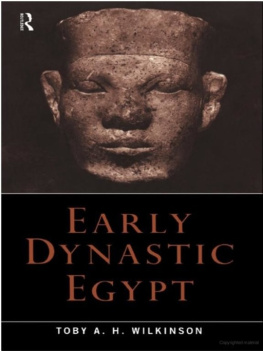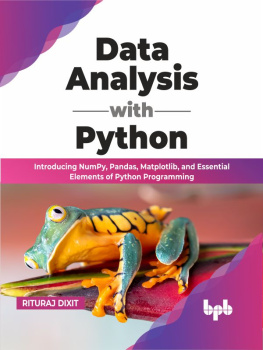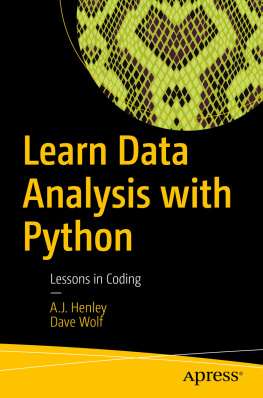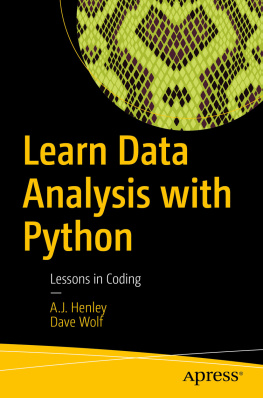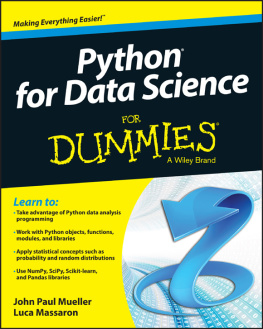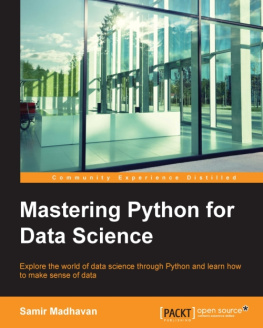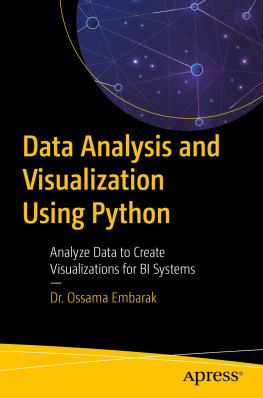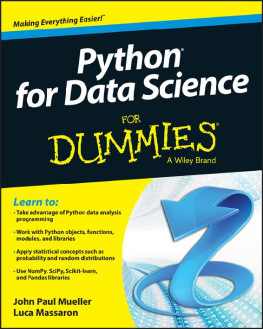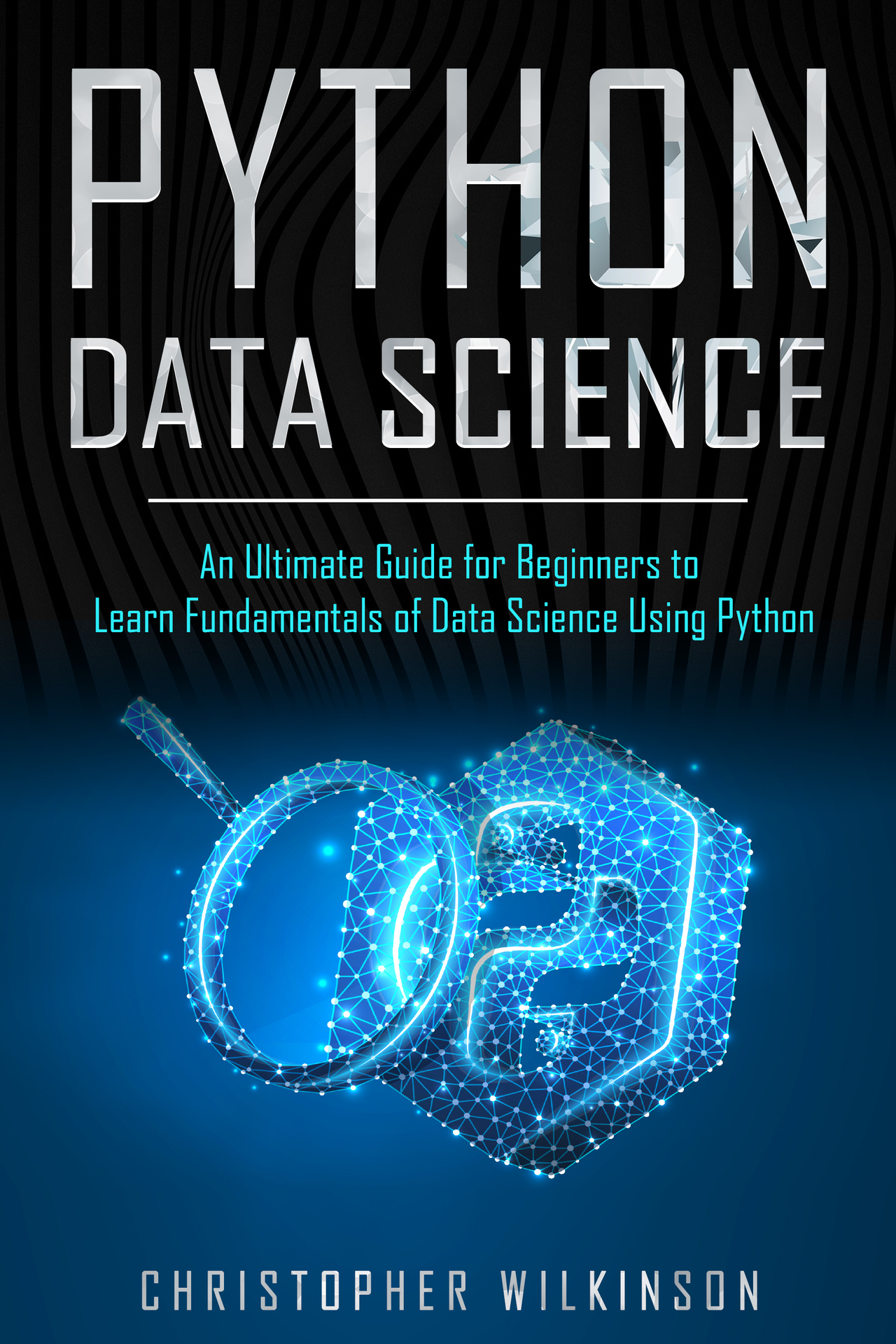Python Data Science
An Ultimate Guide for Beginners to Learn Fundamentals of Data Science Using Python
Copyright 2019 by Christopher Wilkinson - All rights reserved.
This document is geared towards providing exact and reliable information in regards to the topic and issue covered. The publication is sold with the idea that the publisher is not required to render accounting, officially permitted, or otherwise, qualified services. If advice is necessary, legal or professional, a practiced individual in the profession should be ordered.
- From a Declaration of Principles which was accepted and approved equally by a Committee of the American Bar Association and a Committee of Publishers and Associations.
In no way is it legal to reproduce, duplicate, or transmit any part of this document in either electronic means or in printed format. Recording of this publication is strictly prohibited and any storage of this document is not allowed unless with written permission from the publisher. All rights reserved.
The information provided herein is stated to be truthful and consistent, in that any liability, in terms of inattention or otherwise, by any usage or abuse of any policies, processes, or directions contained within is the solitary and utter responsibility of the recipient reader. Under no circumstances will any legal responsibility or blame be held against the publisher for any reparation, damages, or monetary loss due to the information herein, either directly or indirectly.
Respective authors own all copyrights not held by the publisher.
The information herein is offered for informational purposes solely, and is universal as so. The presentation of the information is without contract or any type of guarantee assurance.
The trademarks that are used are without any consent, and the publication of the trademark is without permission or backing by the trademark owner. All trademarks and brands within this book are for clarifying purposes only and are the owned by the owners themselves, not affiliated with this document.
Table of Contents
An Ultimate Guide for Beginners to Learn Fundamentals of Data Science Using Python 2
Chapter 1: Basics of Python for Data Science
1.1 What is Data Science?7
1.2 Python and its History7
1.3 Unique Features and Philosophy7
1.4 Python Applications9
1.5 Why Python to Conduct Data Analysis10
1.6 Python Version List11
1.7 How to Install Python11
CHAPTER: 2 Python Functions and File Handling
2.1 Functions in Python13
2.2 File Handling of Python42
Chapter 3: Variables, Operators, and Data Types of Python
3.1 Variables of Python44
3.2 Operators in Python45
3.3 Python Data Types49
Chapter 4: Python Regular Expressions, Statements, Loops
4.1 Python Regular Expressions55
4.2 Python Statements55
4.3 Loops in Python61
Chapter 5: Python OOPs Concepts
5.1 Python OOPs Concepts68
5.2 Python Class and Objects70
5.3 Python Constructor71
5.4 Python Inheritance74
5.5 Python Stack and Queue79
Chapter 6: Python Modules, Exceptions and Arrays
6.1 Python Modules83
6.2 The Exceptions in Python92
6.3 Python Arrays94
Chapter 7: Python Data Science Libraries and General Libraries
7.1 Python Data Science Libraries97
7.2 Python General Libraries103
CHAPTER 8: Python Interpreters, Compilers, IDEs and Text Editor 115
10.2 Factors behind the Python growth in Modern World136
Conclusion
Introduction
Python is a well-known, high-level object-oriented programming language that is used by many software designers and data scientists across the globe. Guido van Rossum structured this in 1991, and Python Software Company has further developed it. Despite the fact that there were many OOP languages, the principal reason to build this language was to underscore code coherence, and logical and numerical processing (for example NumPy, SymPy, Orange). Python's syntax is simple and short. It is an open-source and versatile language that supports a large standard library.
Python is a broadly useful programming language that is well known for information science. Organizations worldwide are using Python to collect bits of knowledge from their information and addition a focused edge. In contrast to other Python instructional exercises, this comprehensive book on Python is explicitly for data science. It has a collection of amazing approaches to store and control information and accommodating information science apparatuses to direct your own examinations.
In the contemporary world, every business is focused on data security, management, and utility. All the renowned companies are playing with data through complex Python algorithms to store, manipulate, and process data to get useful information and to use it materially to benefit the business. Have you ever thought about Facebook pixels to re-target you on your profile page with the same product you viewed on an e-commerce website? Or Google's recommendations based on a place you visited previously? Nowadays, Android Speech Recognition and Apple Siri understand your speech signals with accuracy and respond to you accordingly. In all these high-tech products, there are algorithms and complex codes of machine language structured by Python.
This book "Python Data Science," an Ultimate Guide for Beginners to Learn Fundamentals of Data Science Using Python, I offer an extraordinary approach toward learning this high-level language to equip you with a complete method of using Python for big data management. As technology is growing fast, every organization requires a highly efficient system for processing data to achieve desired results. It is a detailed book with a comprehensive knowledge of data science, Python data structures, standard libraries, data science frameworks, and predictive models in Python.
Chapter 1: Basics of Python for Data Science
1.1 What is Data Science?
Data science is a gathering of different instruments, data interfaces, and calculations with AI standards (algorithms) to find concealed patterns from raw data. This data is put away in big business data distribution warehouses and utilized in inventive approaches to create business value.
A data examiner (analyst) and a data scientist are unique. An analyst attempts to process the data history and clarify what is happening. Whereas a data researcher needs different propelled calculations of AI (algorithms of machine learning) for an event of a specific occasion by utilizing analysis.
1.2 Python and its History
Python is a translated, high level, universally useful programming language. Developed by Guido van Rossum and first discharged in 1991, Python's plan reasoning accentuates code clarity with its eminent utilization of critical whitespace. Its language develops and object-arranged methodology plan to enable software engineers to compose clear, sensible code for small and big scale projects.
Python was first developed in the late 1980s as a successor to the ABC language. Python 2.0, discharged in 2000, presented highlights, like rundown perceptions and a trash gathering framework, fit for gathering reference cycles. Python 3.0, discharged in 2008, was a noteworthy modification of the language, and much of the Python 2 code doesn't run unmodified on Python 3. Language designer Guido van Rossum carried sole duty regarding the undertaking until July 2018, yet now shares his administration as an individual from a five-man directing council.



